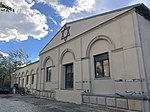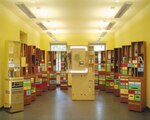Dresden-Neustadt station

Dresden-Neustadt station (German: Bahnhof Dresden-Neustadt) is the second largest railway station in the German city of Dresden after Dresden Hauptbahnhof and is also a stop for long-distance traffic. It is the junction for rail traffic on the northern side of the Elbe. It was built in 1901, replacing the Leipziger Bahnhof (Leipzig line station), which was opened in Leipziger Vorstadt in 1839, and the Schlesischen Bahnhof (Silesian line station), which was opened in 1847. The station building in the district of Innere Neustadt (inner new city) was built in the monumental style that was typical of the time, underlining its importance as a stop for long-distance services. It is linked via the Dresden railway junction and the Dresden Hauptbahnhof (main station) to the Děčín–Dresden railway and to the tracks of the Leipzig–Dresden railway and the Görlitz–Dresden railway, which carry traffic towards Leipzig, Berlin and Upper Lusatia.
Excerpt from the Wikipedia article Dresden-Neustadt station (License: CC BY-SA 3.0, Authors, Images).Dresden-Neustadt station
Schlesischer Platz, Dresden Innere Neustadt (Neustadt)
Geographical coordinates (GPS) Address External links Nearby Places Show on map
Geographical coordinates (GPS)
| Latitude | Longitude |
|---|---|
| N 51.065555555556 ° | E 13.740833333333 ° |
Address
Bahnhof Dresden-Neustadt
Schlesischer Platz
01097 Dresden, Innere Neustadt (Neustadt)
Saxony, Germany
Open on Google Maps










